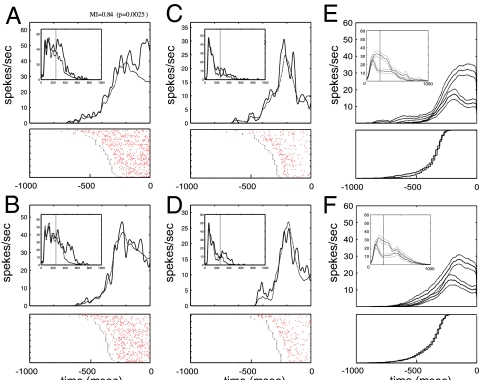Fig. 2.
Modulation of neuronal response during covert visual search for conjunctions of color and motion. (A–D) Responses of a typical MT neuron to a search-array stimulus in the RF under target-present condition (Experiment I condition I.1–4). Each image contains (i) spike density function (SDF, continuous line, 10-ms bins) for the indicated condition aligned at saccade onset, plotted along with corresponding baseline (broken line, data from target-absent trials), (ii) stimulus onset-aligned SDF (Inset), and (iii) response rasters aligned to saccade onset (Each dot in raster plot is an action potential. Short vertical lines represent onset times for search display. Trials sorted by saccade latency.) The broken vertical line indicates the shortest latency time so that the saccade-aligned SDF right to the line (left to the line for the stimulus-aligned SDF in the Inset) represents the mean activation vertically. The number of trials contributing to the left side of the saccade-aligned SDF depends on time and is included as the validation for the saccade-aligned baseline calculation method used herein (see Materials and Methods). (A) When the RF stimulus was a target moving in the preferred direction (condition I.1), the neuronal response nearly doubled relative to baseline beginning ≈100 ms before the saccade. No such modulation was seen for condition I.2, when RF stimulus was a nontarget moving in preferred direction (B) or conditions I.3 and I.4, when RF stimulus moved in antipreferred direction (C and D). (E and F) Population-averaged spike-density functions (solid lines) and standard errors (broken lines) to preferred and anti-preferred directions when each was a target (conditions I.1–2) (E) and nontarget (conditions I.3–4) (F). The difference between responses elicited by preferred and antipreferred directions was significantly greater when RF stimulus was a target. Cumulative saccade latency histograms (below-average SDFs) reveal that the distributions were nearly identical for preferred and antipreferred directions of motion in the RF.

